Magnets to Adversaries—An Analysis of the Attacks on Public Cloud Servers
Abstract
:1. Introduction
- First, the companies leveraging the cloud do not have the same security expertise as the cloud service provider to protect the IaaS, PaaS, and SaaS components. Frequent and independent third-party audits vet the cloud service provider’s security controls, making its security responsibility trustworthy, which is not affordable to many companies leveraging the cloud. The security gap between both implies that the IaaS components implemented by an average cloud customer are less secure than the IaaS components implemented by the cloud service provider;
- Second, there is always a risk of cloud customers assuming a false sense of security regarding their workloads on the cloud platform, believing that their servers are automatically protected by the security controls and the compliance obligations of the cloud provider;
- Third, the security of data center applications significantly differs from how cloud workloads need to be secured. Most organizations move their workloads to the cloud as a cost-saving tactic. As a result, there is a risk that cloud customers may oversimplify the security of these applications moving to the cloud and assume that the same strategies that had previously worked in the data center would continue to be effective in the cloud platform as well. However, such an assumption is far from the truth;
- The fourth and most impactful is the agility of the cloud platform. In a typical enterprise network with DMZ and perimeter firewalls, opening a port to the internet is an arduous process that requires multiple signoffs and implementations from various departments within an organization. In a typical cloud platform, this process would take seconds by a single person. A small oversight in the cloud configuration could expose ports in an IaaS virtual machine or even allow data to be readable by anyone on the internet. The chance of security mistakes is thus significantly higher in the cloud, especially for those organizations that treat the cloud as an extension of the data center security model.
1.1. Hypothesis Statement
1.2. Research Objectives
- Architect a robust honeypot model that efficiently captures characteristics of a typical adversary attacking the cloud infrastructure;
- Derive the adversary characteristics by utilizing the honeypot model on multiple cloud service providers;
- Establish a risk-based control framework based on the identified findings that organizations can use to mitigate the underlying risk from these adversaries.
2. Related Work
- Attackers with the intention of damaging the network;
- Attackers with restricted available resources and time;
- Attackers whose goal is to discover useful information;
- Attackers with no well-known support.
2.1. Novelty of Current Research
3. Materials and Methods
- Multiple Protocols: A honeypot deployed on a single port fails to study and contrast the adversary behavior across different protocols and their corresponding mechanisms of attack. The current study implements a honeypot design that allows adversary interaction on five protocols: SSH, FTP, Telnet, HTTP, and SMB (see Table 2);
- Extensions to Opensource Honeypots: The starting point for each honeypot implemented is an open-source repository. However, honeypots are fragile services. Therefore, extensions were implemented to the available source code to increase the redundancy and improve the availability of the honeypots. The changes to the existing code focused on three main areas: (1) enabling auto-repair in the event of failures, (2) enabling consistent logging across honeypots for ease of contrasting attack data, and (3) enabling code optimizations to prevent resource leakages;
- Multicloud Contrasting: This work focuses on contrasting adversary activity between four top cloud providers in the US, namely Amazon Web Services (AWS), Microsoft Azure (Azure), Google Cloud Platform (GCP), and Oracle Cloud Infrastructure (OCI). The contrast between the four top cloud providers would be possible if the same honeypot infrastructure is deployed across the platforms. Based on the magic quadrant from Gartner from July 2021, three of the cloud platforms selected for this study are established leaders, while OCI is a niche player in the cloud market [18];
- Unrestricted Implementation: Only medium- and high-interaction honeypots are selected for current research. The honeypots and their underlying configuration allow the adversaries to log in using any username and password and exploit the system in any manner they can;
- Redundant Logging: Honeypots are configured to comprehensively log all the attacks from various adversaries, including the client information and metadata. The logging infrastructure is set up in a redundant environment, and logs are collected in real time. In addition, there are several anti-honeypot tools available on the internet [19]. Hence, even if the honeypot servers are compromised, the currently configured design does not allow any availability and integrity impacts on the previously collected logs;
- Extended Execution: All the honeypots across cloud platforms are configured to have high availability and run for the same amount of time between 4 February 2022 and 15 April 2022. A redundant design with automated failovers is configured to ensure all the honeypots’ availability is more than 99.5% across all the cloud platforms over the time duration above;
- Hiding from Adversaries: The public IP addresses of the honeypots were selected from a random pool of IP addresses from the cloud platform. Custom scripting was in place for automated rotation of the public IP every day for the honeypots deployed on the AWS cloud and an ad hoc basis for other cloud platforms. No efforts were made to disclose the IP addresses and the vulnerable services to the adversaries.
3.1. Cloud Architecture
3.2. Virtual Machine Setup
3.3. Availability and Monitoring Setup
- Each honeypot implementation was set up as a separate docker-compose file. Each docker infrastructure supporting a honeypot over a given port was independent of other containers running on the host;
- Upper limits on maximum CPU and memory are defined for each Docker container executing within the virtual machine;
- The docker-compose file automatically triggers new instances of the honeypot containers in case of any error/failure of the underlying code. Further, each adversary attack consumes a unique container instance among the managed pool created by the docker-compose architecture;
- The custom code and docker architecture refresh each honeypot container within the pool at least once an hour at a random time when the external connections to the container do not exist.
4. Results
4.1. Adversary Attack Metrics
4.2. Adversary Profiling
4.3. Common Adversary Strategies
5. Discussion
5.1. Overall Summary
- Cloud service providers are a magnet for adversaries looking for low-hanging fruits. Adversaries are always on a constant lookout for cloud IP addresses through password-based attacks and attacks that would result in a remote shell;
- Configuration mistakes in cloud platforms are often easy to make due to the complexity of cloud services, the evolving nature of technology, and the potential for human error;
- The focus of the attacks is to minimize the efforts to obtain a remote shell, given the port and protocol;
- Once the shell access is obtained, the adversaries’ next step is to either deploy a botnet through the shell that attacks other cloud components or perform cryptocurrency mining;
- Adversaries come from different countries and geographies. They use cloud platforms and other IP masking techniques to hide their activity while attacking cloud infrastructure;
- The adversaries are attracted to the underlying issues of the infrastructure in the cloud. Improper security configuration, lack of authentication security, and poor vulnerability management yield the best results for the adversaries exploiting cloud platforms;
- If a virtual machine exposes the common port on the cloud platform, it is attacked within minutes and several times a day. From an adversary perspective, out of millions of attacks happening across virtual machines hosted in the cloud, a successful response from a single virtual machine expands the adversary attack network.
5.2. Overall Security Control Structure for Mitigation
6. Conclusions
- This work focuses on leveraging the honeypot design to contrast the adversaries’ Tactics, Techniques, and Procedures (TTP) across cloud platforms;
- The security architecture of an application in the data center is different from that in the cloud. Due to increased agility, it is easy to make security mistakes in the cloud. Adversaries want to exploit this aspect and target organizations for quick wins on the cloud platform;
- The more popular the cloud platform is, the more adversary traffic to the exposed infrastructure will be;
- Misconfigurations in cloud platforms frequently occur owing to the intricate nature of cloud services, continuous technological evolution, and the susceptibility to human error, validating our hypothesis at the beginning of the article. These misconfigurations can result in security vulnerabilities and operational disturbances if not promptly identified and rectified;
- The usual behavior of the adversaries is to look for quick wins and target the most impactful vulnerabilities to obtain shell access to the cloud systems. Their main motive is to improve the Return on Attack (ROA) metric by actively scanning vulnerable hosts;
- It is possible to implement simple security controls that make it incrementally difficult for these attackers to compromise the cloud workloads. The proposed control structure would give ample defense in depth in this direction.
Author Contributions
Funding
Data Availability Statement
Conflicts of Interest
References
- Gartner Forecasts Worldwide Public Cloud End-User Spending to Grow 23% in 2021. Available online: https://www.gartner.com/en/newsroom/press-releases/2021-04-21-gartner-forecasts-worldwide-public-cloud-end-user-spending-to-grow-23-percent-in-2021 (accessed on 24 October 2023).
- Shared Responsibility Model—Amazon Web Services (AWS). Available online: https://aws.amazon.com/compliance/shared-responsibility-model/ (accessed on 24 October 2023).
- 2021 Cloud Misconfigurations Report. Available online: https://www.rapid7.com/c/cloud-misconfigurations-2021/ (accessed on 24 October 2023).
- 2023 Cloud Security Study—The Challenges of Data Security and Sovereignty in a Multicloud World. Available online: https://cpl.thalesgroup.com/sites/default/files/content/CLOUD_AMI_pages/2023/2023-cloud-security-study-global-edition.pdf (accessed on 24 October 2023).
- WKLD.06—Use Systems Manager instead of SSH or RDP. Available online: https://docs.aws.amazon.com/prescriptive-guidance/latest/aws-startup-security-baseline/wkld-06.html (accessed on 24 October 2023).
- Connect to Environments Privately. Available online: https://learn.microsoft.com/en-us/azure/cloud-adoption-framework/scenarios/cloud-scale-analytics/architectures/connect-to-environments-privately (accessed on 24 October 2023).
- Securely Connecting to VM Instances. Available online: https://cloud.google.com/solutions/connecting-securely (accessed on 24 October 2023).
- Securing Compute. Available online: https://docs.oracle.com/en-us/iaas/Content/Security/Reference/compute_security.htm (accessed on 24 October 2023).
- Ketabdar, H.; Rezaee, R.; GhaemiBafghi, A.; Khosravi-Farmad, M. Network security risk analysis using attacker’s behavioral parameters. In Proceedings of the 6th International Conference on Computer and Knowledge Engineering (ICCKE), Masshad, Iran, 20 October 2016. [Google Scholar]
- Devi, B.T.; Shitharth, S.; Jabbar, M.A. An appraisal over intrusion detection systems in cloud computing security attacks. In Proceedings of the 2nd International Conference on Innovative Mechanisms for Industry Applications (ICIMIA), Bengaluru, India, 5–7 March 2020. [Google Scholar]
- Rushikesh, K. Study on Honeypot Based Secure Network System. Int. J. Adv. Res. Comput. Sci. 2019, 10, 71–72. [Google Scholar] [CrossRef]
- Majumdar, S.; Madi, T.; Wang, Y.; Jarraya, Y.; Pourzandi, M.; Wang, L.; Debbabi, M. User-level runtime security auditing for the cloud. IEEE Trans. Inf. Forensics Secur. 2018, 13, 1185–1199. [Google Scholar] [CrossRef]
- Negi, P.S.; Garg, A.; Lal, R. Intrusion detection and prevention using honeypot network for cloud security. In Proceedings of the 10th International Conference on Cloud Computing, Data Science Engineering (Confluence), Noida, India, 29–31 January 2020. [Google Scholar]
- Lihet, M.A.; Dadarlat, V. How to build a honeypot system in the cloud. In Proceedings of the 14th RoEduNet International Conference—Networking in Education and Research (RoEduNet NER), Craiova, Romania, 24–26 September 2015. [Google Scholar]
- Lihet, M.; Dadarlat, V. Honeypot in the cloud five years of data analysis. In Proceedings of the 17th RoEduNet Conference: Networking in Education and Research (RoEduNet), Cluj-Napoca, Romania, 6–8 September 2018. [Google Scholar]
- Barth, A.; Rubinstein, B.I.P.; Sundararajan, M.; Mitchell, J.C.; Song, D.; Bartlett, P.L. A learning-based approach to reactive security. IEEE Trans. Dependable Secur. Comput. 2012, 9, 482–493. [Google Scholar] [CrossRef]
- Priya, V.S.D.; Chakkaravarthy, S.S. Containerized cloud-based honeypot deception for tracking attackers. Sci. Rep. 2023, 13, 1437. [Google Scholar] [CrossRef] [PubMed]
- Magic Quadrant for Cloud Infrastructure and Platform Services. Available online: https://www.gartner.com/document/4020235 (accessed on 24 October 2023).
- Krawetz, N. Anti-honeypot technology. IEEE Secur. Priv. 2004, 2, 76–79. [Google Scholar] [CrossRef]
- Apache Log4j Vulnerability Guidance. Available online: https://www.cisa.gov/uscert/apache-log4j-vulnerability-guidance (accessed on 24 October 2023).
- One of the 32 Million with a Rockyou Account? You May Want to Change all Your Passwords Like Now. Available online: https://techcrunch.com/2009/12/14/rockyou-hacked/ (accessed on 24 October 2023).
- Doublepulsar—A Very Sophisticated Payload for Windows. Available online: https://www.secpod.com/blog/doublepulsar-a-very-sophisticated-payload-for-windows/ (accessed on 24 October 2023).
- AWS Security Checklist. Available online: https://d1.awsstatic.com/whitepapers/Security/AWS_Security_Checklist.pdf (accessed on 24 October 2023).
- Azure Operational Security Best Practices. Available online: https://learn.microsoft.com/en-us/azure/security/fundamentals/operational-best-practices (accessed on 24 October 2023).
- Google Cloud Security Foundations Guide. Available online: https://services.google.com/fh/files/misc/google-cloud-security-foundations-guide.pdf (accessed on 24 October 2023).
- Best Practices Framework for Oracle Cloud Infrastructure. Available online: https://docs.oracle.com/en/solutions/oci-best-practices/ (accessed on 24 October 2023).
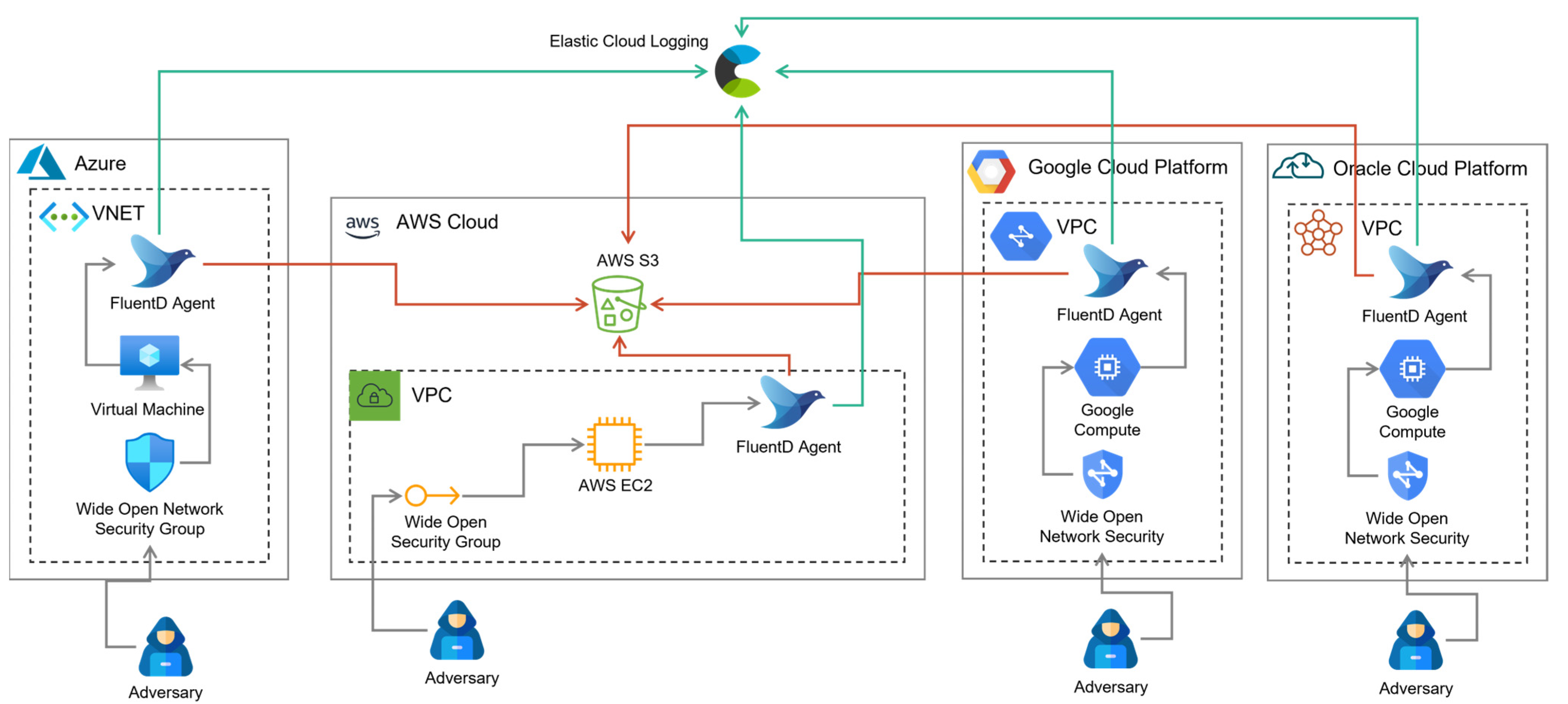
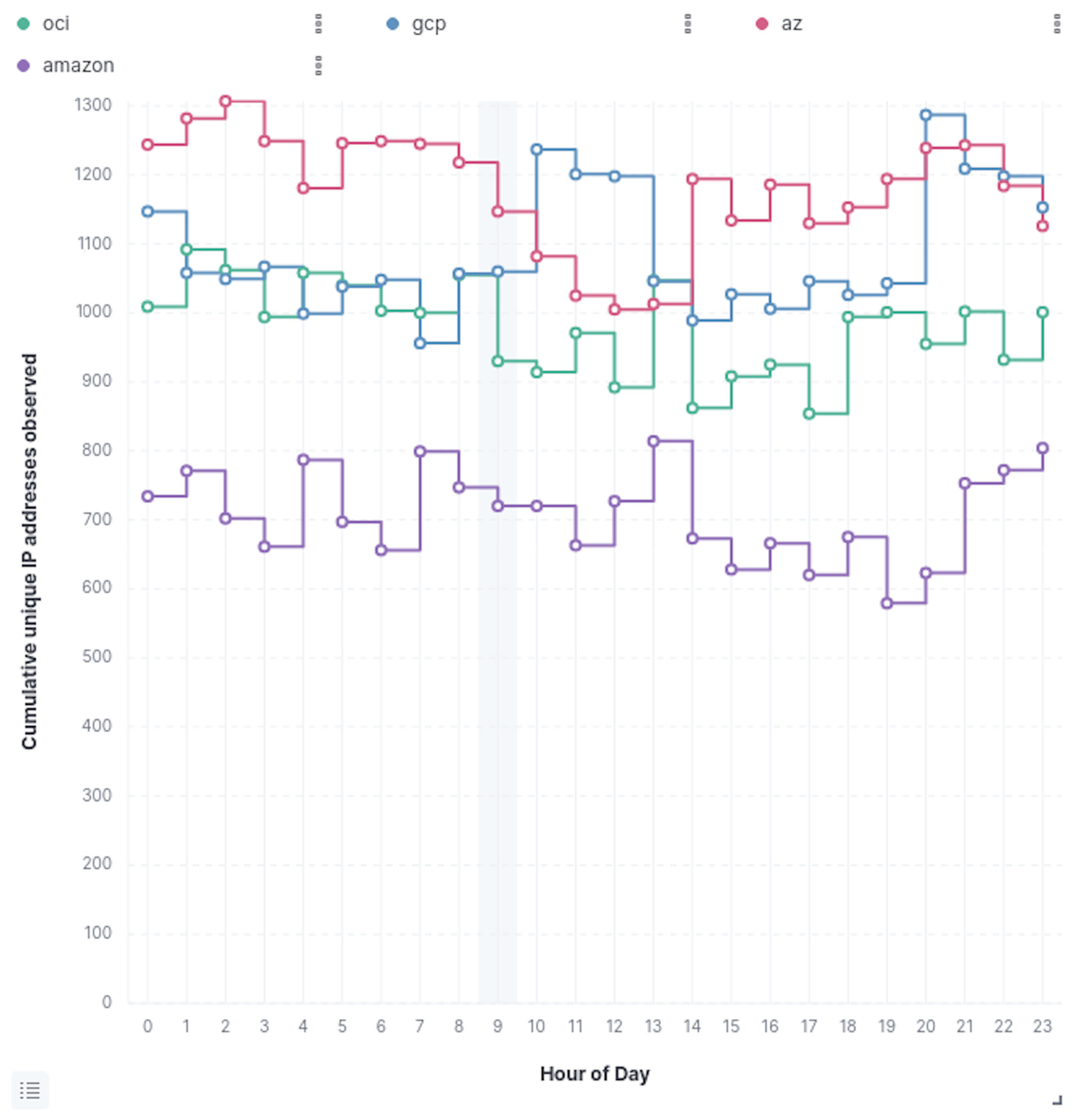
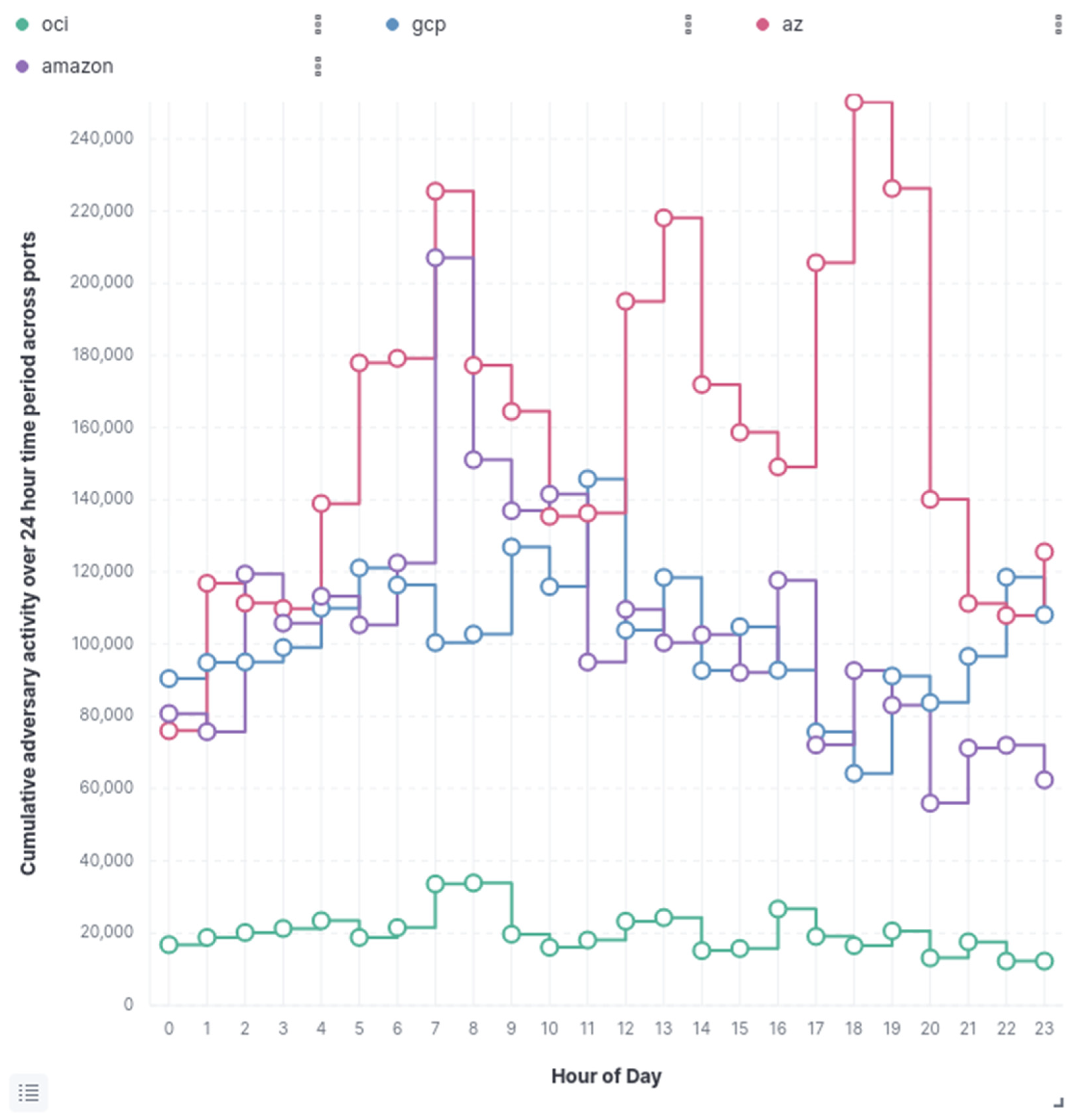
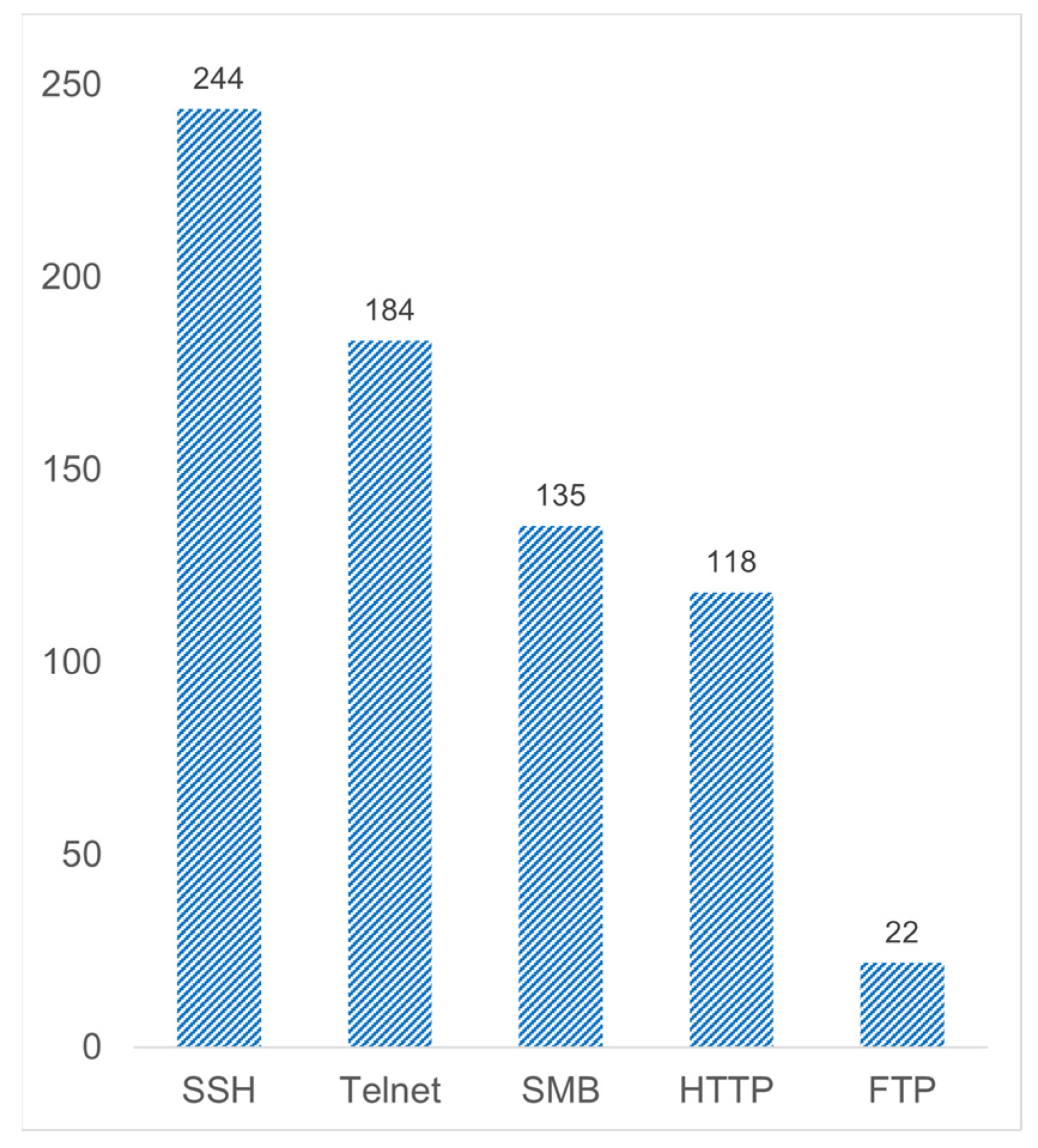
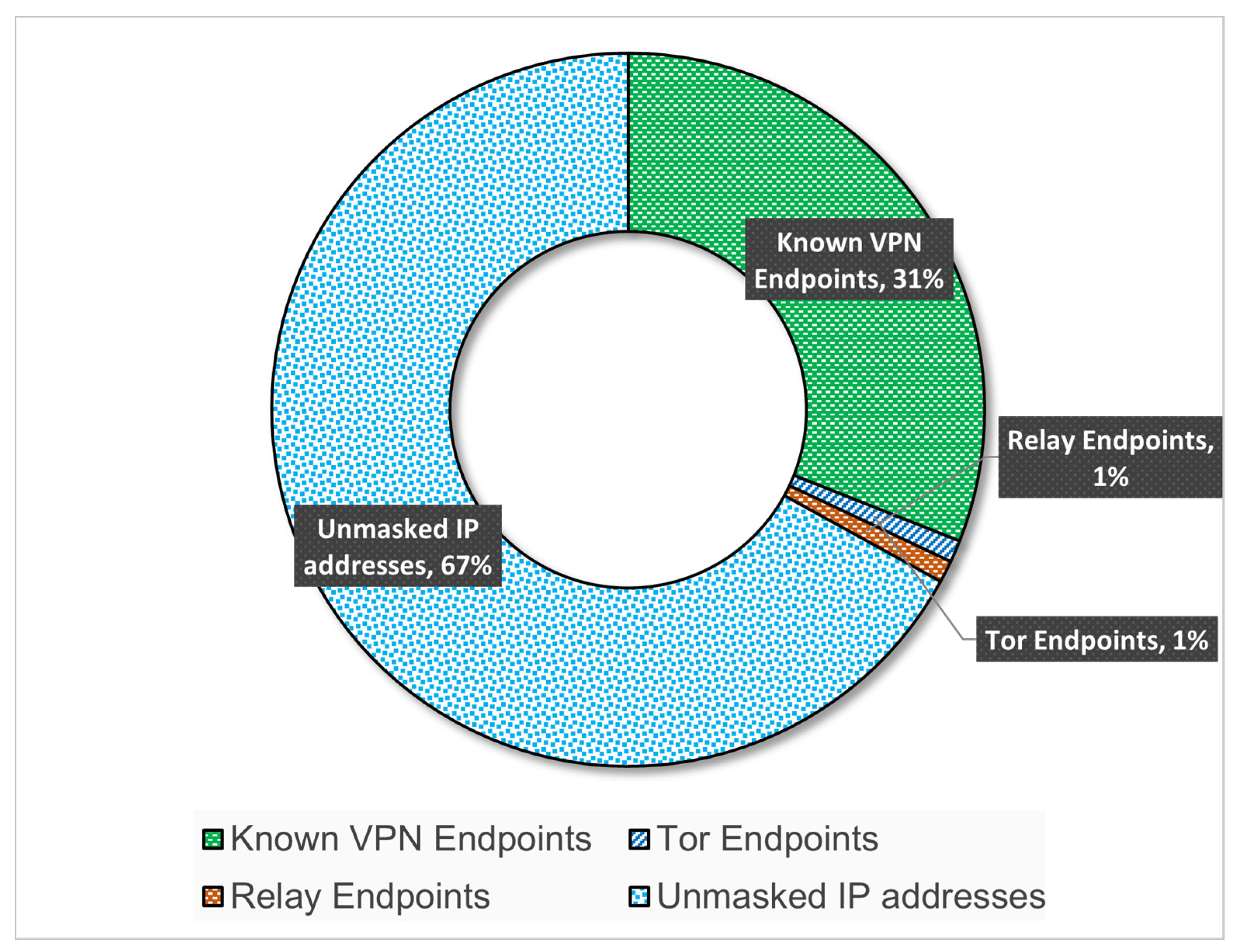
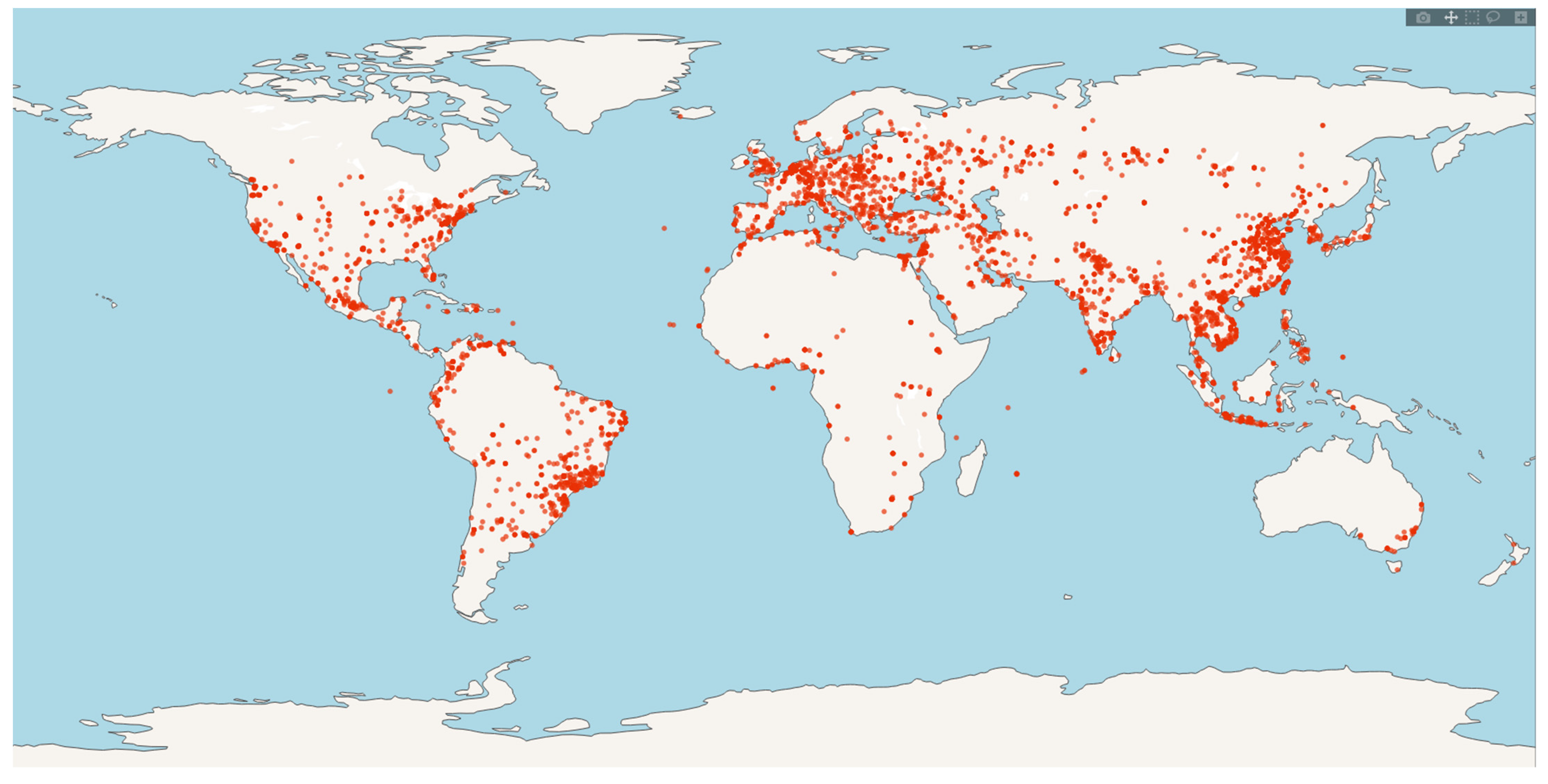
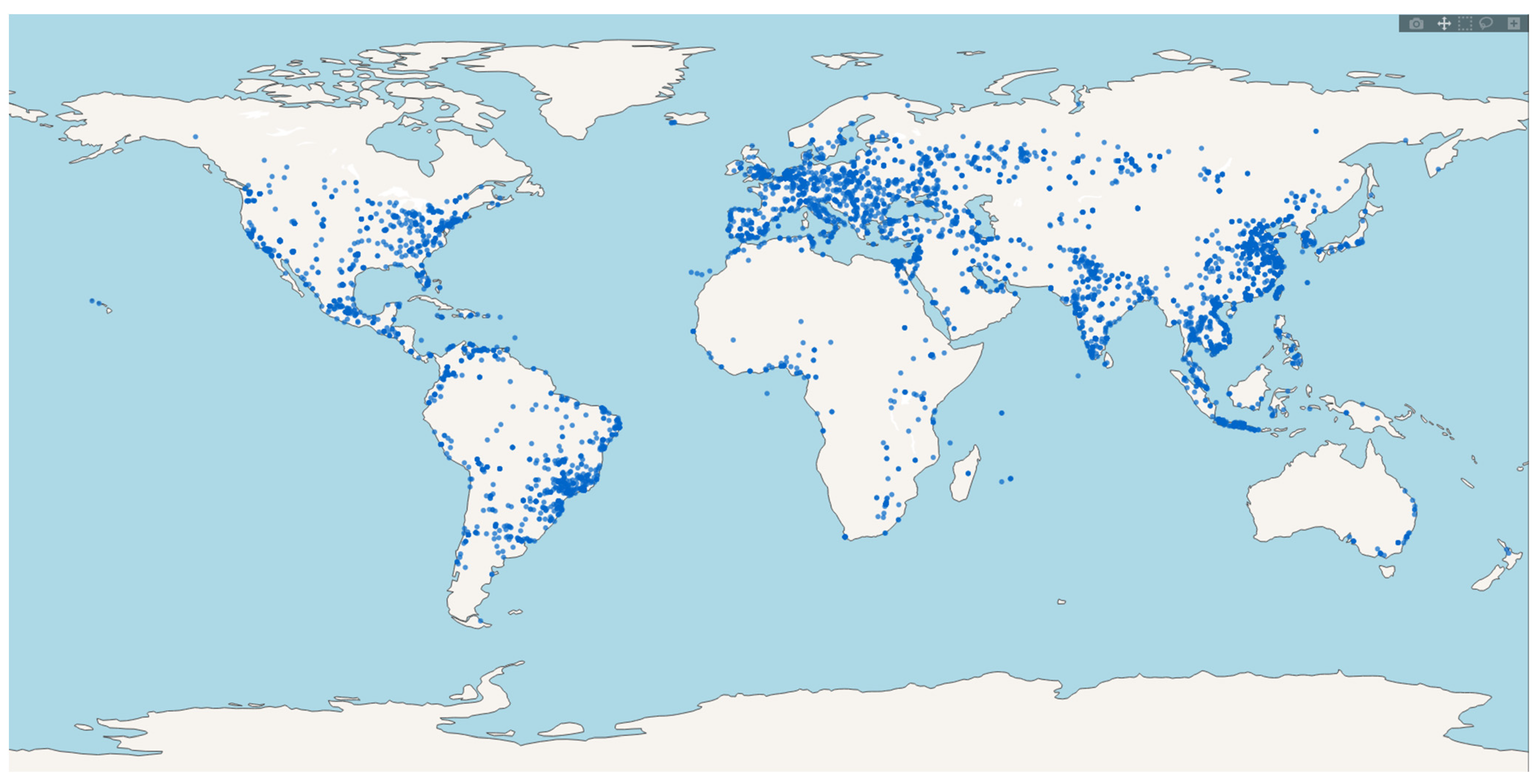
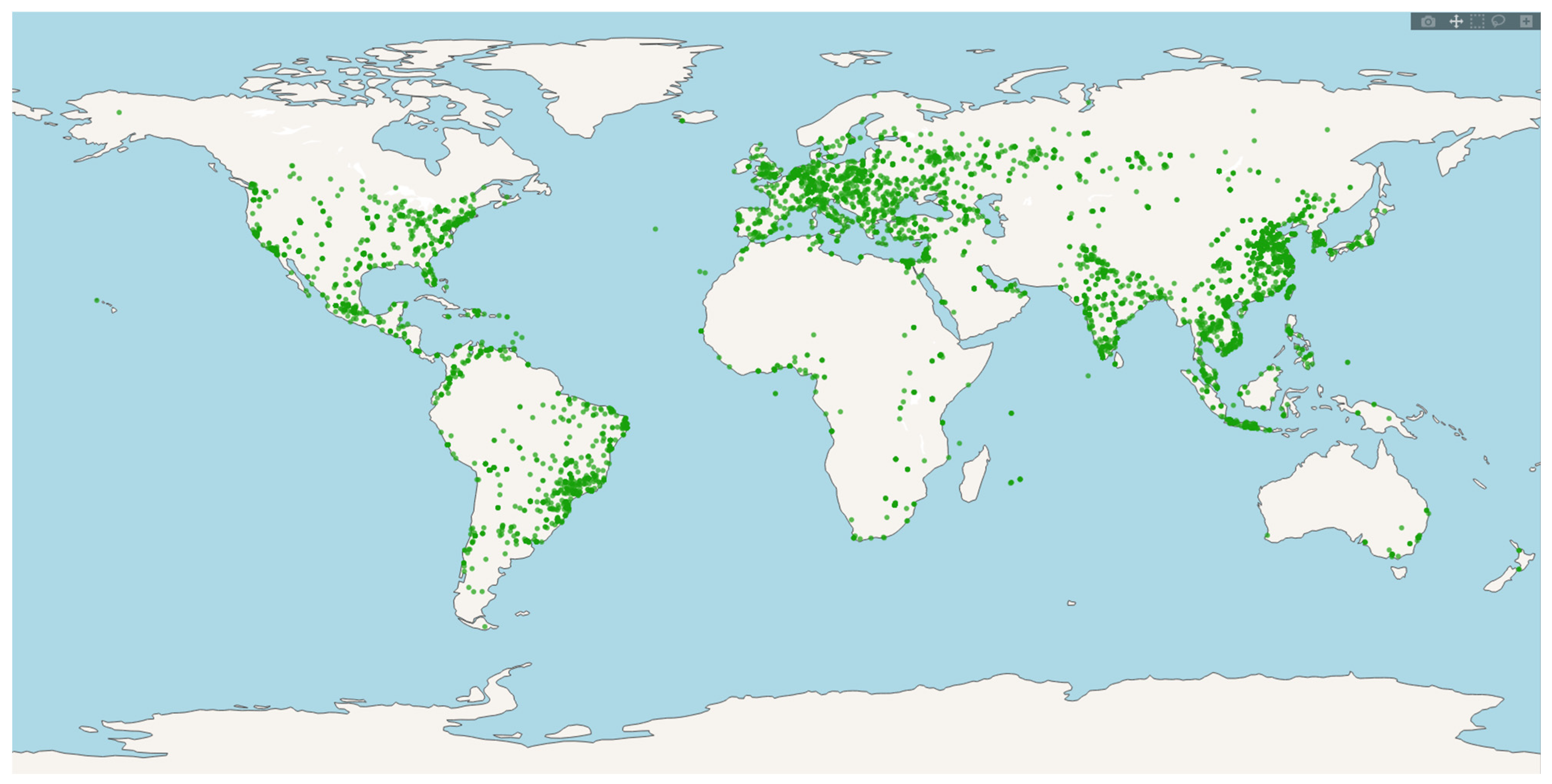
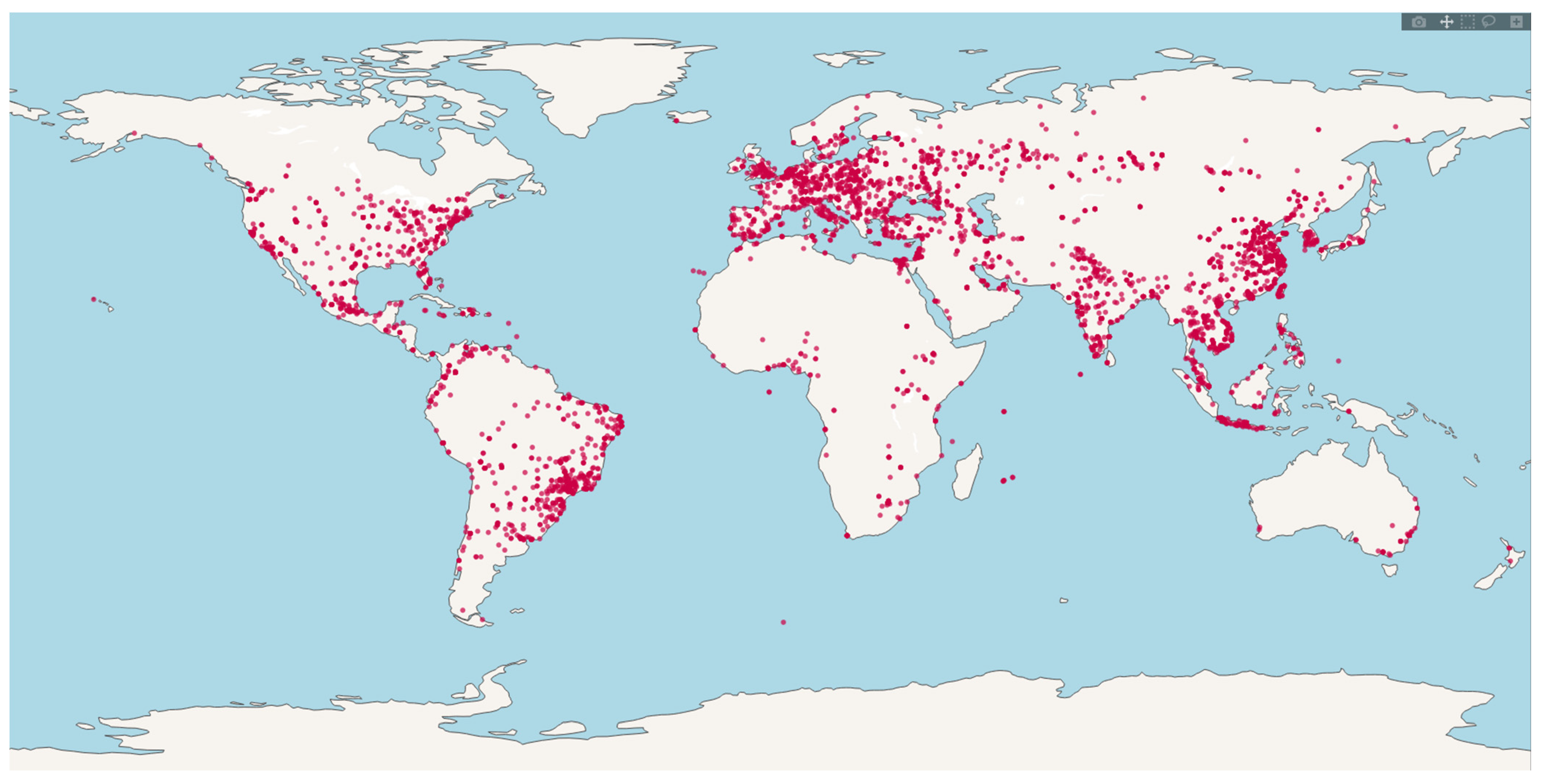
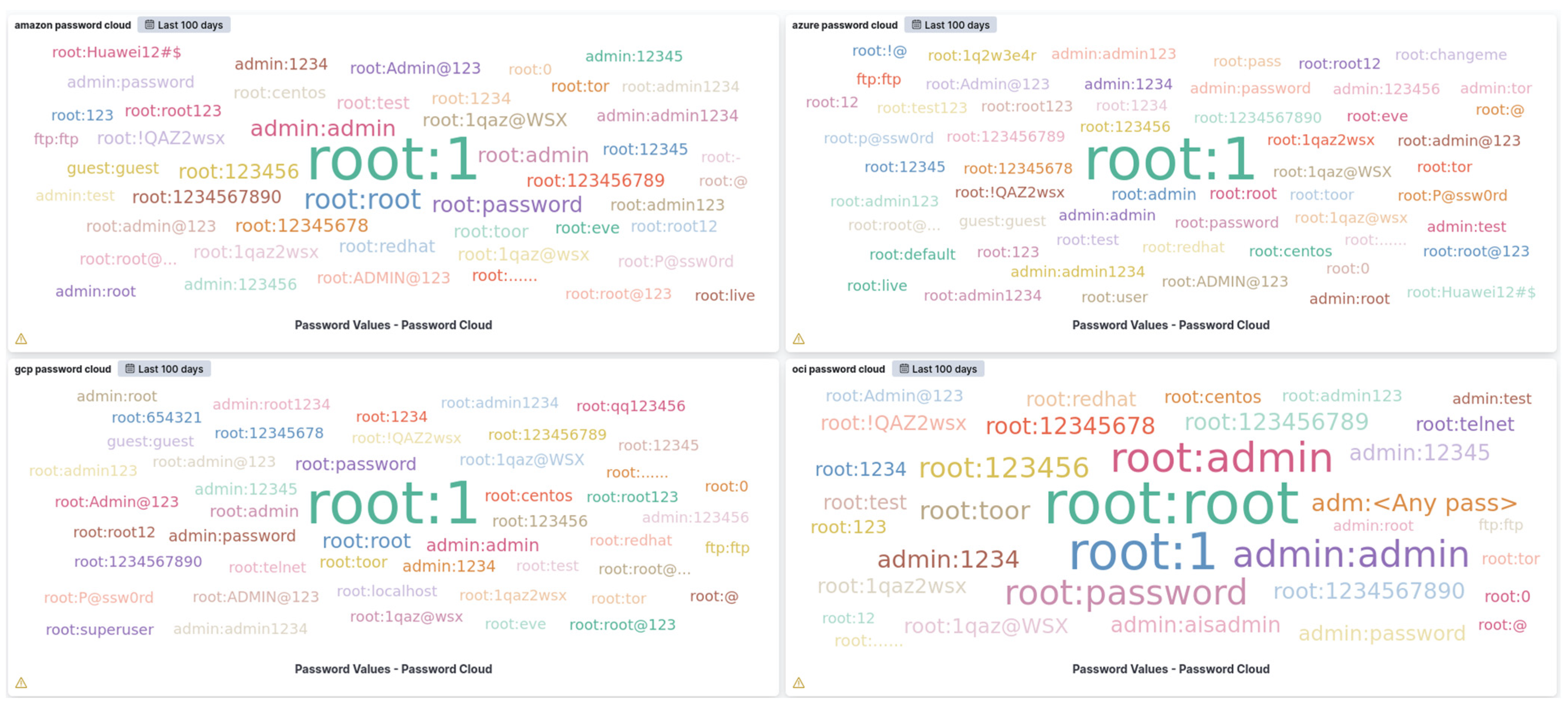

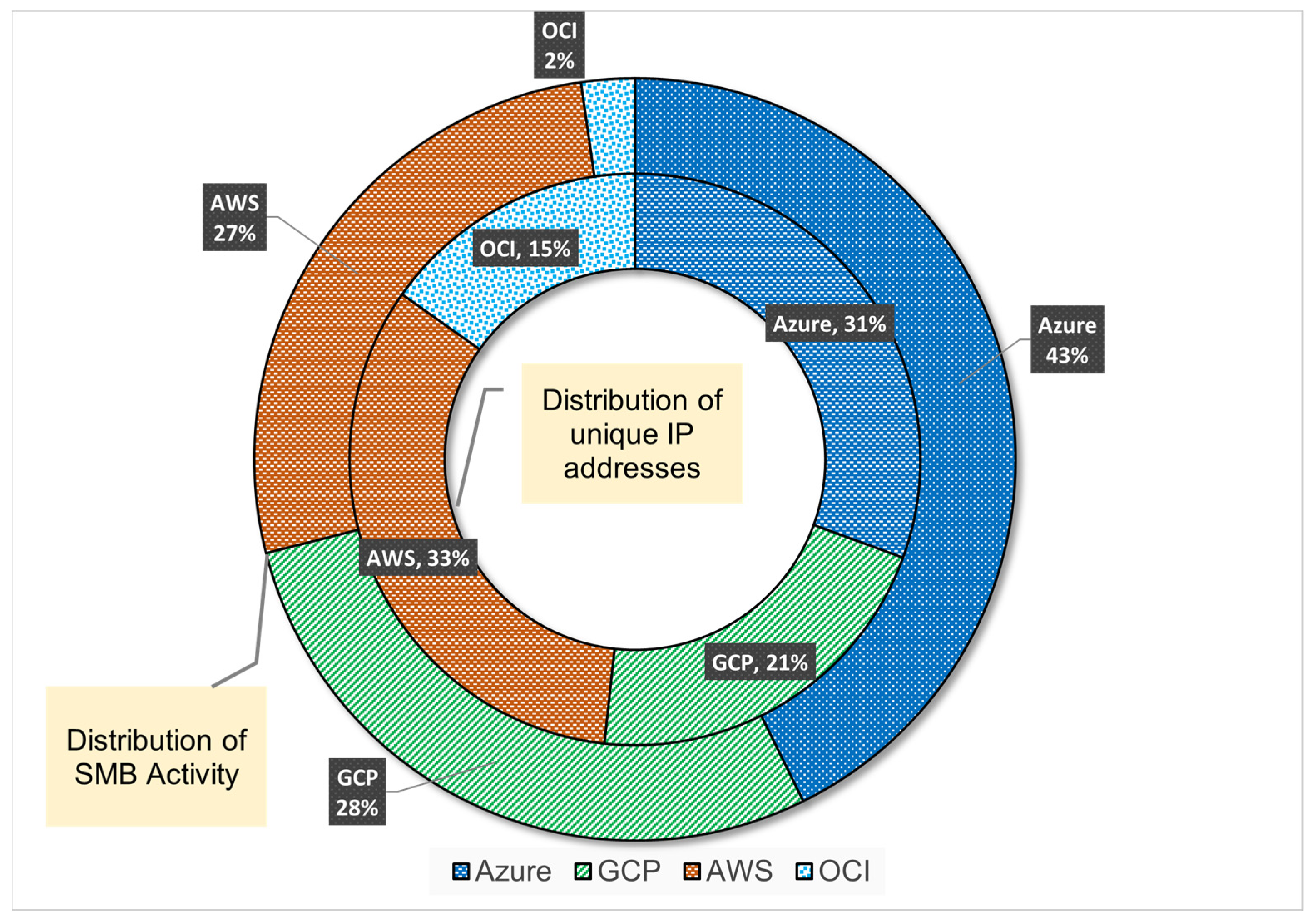
| # | Cloud Platform | Estimated SSH Endpoints Exposed |
|---|---|---|
| 1 | Amazon Web Services (AWS) | 2.7 million |
| 2 | Microsoft Azure | 350 thousand |
| 3 | Google Cloud Platform (GCP) | 1.6 million |
| 4 | Oracle Cloud Infrastructure (OCI) | 413 thousand |
| # | Port | Honeypot Type | Service | Open-Source Honeypot | Honeypot Configuration |
|---|---|---|---|---|---|
| 1 | 21/ftp | High-interaction | Linux FTPd | Meltingpot 1 | Accepts anonymous FTP access. Provides the FTP prompt and listens to the user’s actions. Provides attacker access to certificate files, GitHub configuration scripts, and initialization data. |
| 2 | 22/ssh | High-interaction | OpenSSH 7.9p1 | Wetland SSH 2 | Since it is a high-interaction honeypot, accepting the password on the first malicious attempt raises suspicion of an adversary. Hence, the honeypot is configured to accept any password only after a random two or three wrong password retries. Offers full SSH shell within a Docker container with scripting capabilities. The user’s commands are logged outside the container in real time. |
| 3 | 23/telnet | Medium-interaction | Linux Telnetd | Cowrie 3 | Mimics SSH honeypot; however, the random tries are increased to six to eight attempts. The honeypot is based on Cowrie, a medium-interaction honeypot with a fake filesystem. |
| 4 | 80/http 8080/http 8983/http 9200/http | Medium-interaction | Elastic Search | Log4pot 4 | Hosts a website that mimics Elastic Search, which was vulnerable to Log4j vulnerability [20]. The honeypot listens to the requests coming to the HTTP service and identifies and logs the attacks specifically targeting the Log4j vulnerability. |
| 5 | 445/smb | High-interaction | Microsoft Windows SP2 SMB | Dionaea 5 | Emulates Windows XP-hosted SMB service. Provides access to an empty directory. The honeypot logs any SMB packet sent to it and identifies different types of SMB attack payloads. |
| 6 | 55293/ssh | NA | NA | NA | Management port for honeypot server maintenance. This port also serves as the control port to contrast the traffic between known ports of a protocol and an obscure/hidden port. |
| Control Domain | Sample Security Controls |
|---|---|
| Network Security | NS-1: The attack surface of the infrastructure in the cloud must be kept to a minimum. Every port and protocol open to the internet must have a valid business justification for such exposure. |
| NS-2: The management services such as SSH and Telnet services must not be exposed to the internet. If these services are required to be exposed, they must use non-standard ports that are randomly determined. | |
| Access Control | AC-1: The access must be restricted using multifactor authentication instead of a single-factor mechanism. Service-based access to cloud services must occur over mutual TLS authentication. |
| AC-2: The services exposed to the internet must authorize all the entities and validate for access privileges before allowing remote access. | |
| AC-3: The passwords within services implemented in the cloud must adhere to the most stringent password complexity settings. At a minimum, the password must require a length of 12 characters, with a combination of uppercase, lowercase, digits, and symbols. | |
| AC-4: Weak passwords identified in the vulnerable password lists must not be accepted as passwords for any system deployed on the cloud. | |
| Logging and Monitoring | LM-1: Each service exposed to the internet must log events related to all the successful and failed login attempts. Thresholds must be established on maximum failed login attempts. The attempts exceeding the threshold count must temporarily lock out the underlying user. |
| LM-2: Protocol errors related to the service must be logged and monitored to identify any signs of compromise. Such alerts must be treated as security incidents and promptly remediated by patching the service or restricting access. | |
| Vulnerability Management | VM-1: The IaaS services on the cloud must be patched regularly. Critical security patches that result in remote code execution must be implemented within 24 h of their release. |
| VM-2: The vulnerability scans must be performed daily to identify any system with pending critical security patches. The findings from such a scan must be treated as an incident and resolved quickly. |
Disclaimer/Publisher’s Note: The statements, opinions and data contained in all publications are solely those of the individual author(s) and contributor(s) and not of MDPI and/or the editor(s). MDPI and/or the editor(s) disclaim responsibility for any injury to people or property resulting from any ideas, methods, instructions or products referred to in the content. |
© 2023 by the authors. Licensee MDPI, Basel, Switzerland. This article is an open access article distributed under the terms and conditions of the Creative Commons Attribution (CC BY) license (https://creativecommons.org/licenses/by/4.0/).
Share and Cite
Lanka, P.; Varol, C.; Burns, K.; Shashidhar, N. Magnets to Adversaries—An Analysis of the Attacks on Public Cloud Servers. Electronics 2023, 12, 4493. https://doi.org/10.3390/electronics12214493
Lanka P, Varol C, Burns K, Shashidhar N. Magnets to Adversaries—An Analysis of the Attacks on Public Cloud Servers. Electronics. 2023; 12(21):4493. https://doi.org/10.3390/electronics12214493
Chicago/Turabian StyleLanka, Phani, Cihan Varol, Kirk Burns, and Narasimha Shashidhar. 2023. "Magnets to Adversaries—An Analysis of the Attacks on Public Cloud Servers" Electronics 12, no. 21: 4493. https://doi.org/10.3390/electronics12214493
APA StyleLanka, P., Varol, C., Burns, K., & Shashidhar, N. (2023). Magnets to Adversaries—An Analysis of the Attacks on Public Cloud Servers. Electronics, 12(21), 4493. https://doi.org/10.3390/electronics12214493






